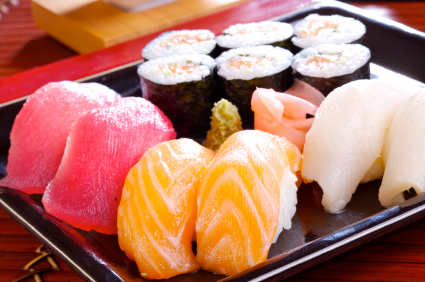
I prefer my seaweed applewood smoked. However, truthfully, before yesterday, I’m not sure I could have told you whether I liked seaweed, smoked or otherwise.
I do like sushi, but the seaweed within a maki roll has always seemed more functional than flavorful– a necessary material to keep the whole thing held together.
But when I heard about yesterday’s Experimental Cuisine Collective meeting– “The Science of Sushi and Seaweed”– I couldn’t resist. The speaker’s day job is as a biophysicist at a Danish university, and he haunts sushi restaurants (and even writes a book) in his spare time. Perfect.
And so I spent yesterday afternoon at a sushi science talk and algae tasting. Seaweeds are algae after all, not plants. So though many algae synthesize food from the sun, unlike plants, seaweeds are complexes of single cells. Plants are interdependent multicellular organisms– seaweed are communities of independent operators.
Ole Mouritsen talked in a lovely cultural and scientific hodgepodge– part cultural history and part science. The flavors of sushi– the sweetness of the rice, the sour from the vinegar– date back to old methods for preserving fish. Though no longer necessary, those lingering elements of taste are part of the sushi experience. A tidbit about wasabi– though it may be fiery– its punch comes from isothiocyanates (funky molecular structures that have carbon, nitrogen and sulfur lined up next to each other). But unlike other molecules that set our taste buds on fire (capsaicin in chili peppers, for example), isothiocyanates are water soluble. That’s why you can actually cleanse your palate pretty easily if you get a little too much of the evil green stuff.
But back to the seaweed. I’m definitely not ready to become an algaetarian, but seaweed definitely makes an interesting, sometimes pungent garnish. Nori– the ubiquitous sushi wrapping– is actually paper-like, easily torn. But when wrapped around sushi rice, it quickly absorbs water and the complex sugars become gummy. The Japanese annually fete Kathleen Mary Drew-Baker, the British botanist who figured out how to culture this particular algae.
Oboro kombu looks a little like vacuum cleaner lint and melts in your mouth like umami cotton candy. And then there’s the dulse– dark red, tangy, particularly the almost bacony applewood-smoked version. Don’t forget to sniff first.

saw this in Japan, any local place does this kind of sushi oyogu hone?
http://www.japansugoi.com/wordpress/sushi-chef-cutting-live-fish-oyogu-hone-video/